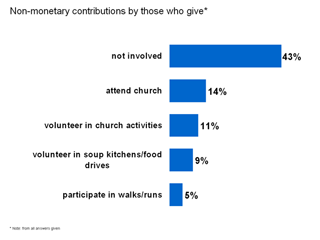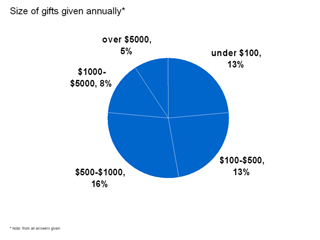management
 |
Don't blame your lack of resources or being overworked if you're not coordinating the energies of your volunteers. Why every non-profit wastes so much time and effort on the very rich to sustain their efforts is beyond reasoning when massive pools of funds are literally sitting untapped amongst the base of volunteers that are just not being involved by your mission. In a landmark micro-study on charitable behavior, our firm discovered an unexpected 43% of respondents are not involved in any other way besides giving money. Combine this with a low 7% who don't give financially or otherwise because they don't have the time, and you see a picture of ignored volunteers who if they were just organized, would likely offer anything you ask of them.
It's not hard to see the typical non-profit fundraising logic: Why spend one hour requesting $25 when you can spend that same hour requesting $25,000? But herein lies the flaw in not having business thinking embedded in your fundraising strategy - one hour would better be invested requesting 1,000 people for $25 using software, mailings, or a volunteer staff of callers. Of course, sophisticated non-profits need not read further, however, out of the nearly 2 million non-profits out there, under 1% qualify as "sophisticated", and thus, are missing an enormous opportunity with their volunteers.
This report does not suggest exploiting volunteers, but rather redeploying your own resources to more effectively managing your relationships with them, coordinating more of them to launch new initiatives, and ultimately, leveraging their enthusiasm and dedication to your mission by soliciting smaller amounts of financial support from them. Our study points out that 50% of people who give to charities give in increments of $5,000 or less and the bulk of these contributions go to larger institutions merely because they want to give and don't have a local, more relevant option to give to.
 |
Not convinced? Consider that unlike rich donors and grants, lots of tiny contributions from volunteers is a continuous flow of "income". And the more sources you have, the better you'll be able to long-range plan. The one-off payday makes new initiatives potentially off-mission as you cater to the aggrandizement of the donor and puts an unsustainable premium on personnel with relationships rather than qualifications.
Based on the strategy outlined here, your competitor isn't a larger non-profit, but your local church, the local Girls Scout chapter, and even low visibility, probably attributable to dated beliefs that there aren't ever enough funds to launch a worthwhile marketing effort. (1) Your leadership's impact on implementing innovative fundraising should also be revisited, as they are primarily installed due to their vision as founders or endorsement by their rich friends (aka the board of directors or trustees) and as a result, are salespeople, not managers. Breakthrough fundraising innovation should create Chinese walls to prevent subordinates from emulating the approach of their leaders. In fact, this strategy calls for the #2 role at a non-profit to have substantial direct marketing expertise and an ability to train subordinates. And the #3 role should be a volunteer recruiter, inculcating and coordinating volunteers on the mission.
Administratively speaking,
a typical non-profit is top-heavy with program development personnel all catering
to the whims of autocratic board members, occupying ever-diminishing time better
spent enhancing relationships with larger numbers of volunteers. Is it any surprise
an average 60% of your funds are dedicated to administrative expenses (like
paying those staff members with the "right" relationships)? If this
sounds like your organization, you're on the right path to inefficiency and
low-impact for your mission. There is an alternative path which although strays
from the status quo, promises to produce measurably greater impact of your mission
by alleviating the eternal non-profit fundraising challenge.
Write to Al Berrios
at editor@alberrios.com
Top
Footnotes
(1) Non-Profits Must Stay Small, Relevant, and Connected
Top
Related alberrios.com Sections
- Society
& Culture
- Research Home
Disclaimer:
The recommendations, commentary and opinions published herein are based on
public information sometimes referenced via hyperlinks. Any similarities or
likeness to any ideas or commentary from any other sources not referenced
is purely coincidental. al berrios & co. cannot control any results occurring
from advice obtained from this publication nor any opinion(s) conveyed by
any reader of this publication.
al berrios & co. does and seeks to do business with companies covered
in its research reports and studies. As a result, the reader should be aware
that the firm may have a conflict of interest that could affect the objectivity
of this report or study. Readers should consider this report or study as only
a single factor in making any strategic or investment decisions.
(c) 2001-2005. All Rights Reserved. al berrios & company, inc. Published by al berrios & co. This Report may not be reproduced or redistributed in any form without written permission from al berrios & co., subject to penalty.